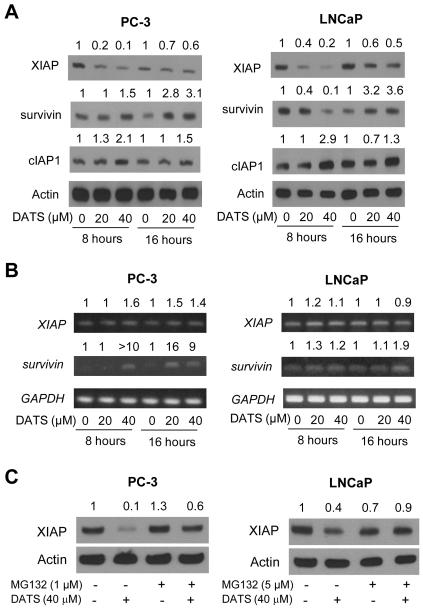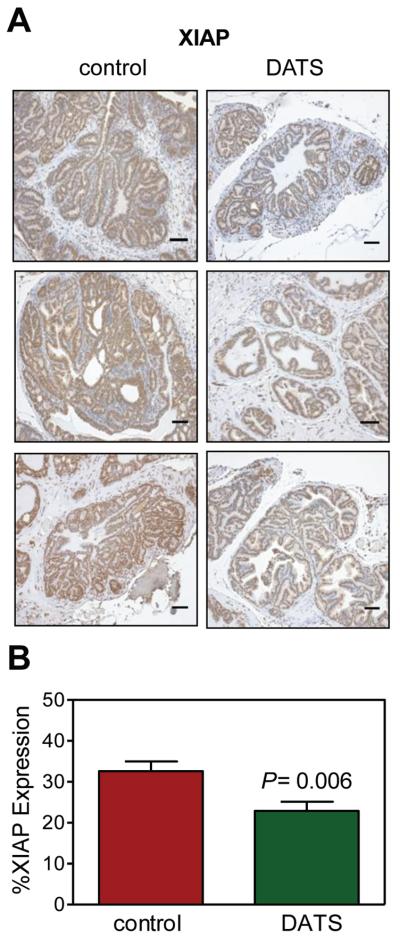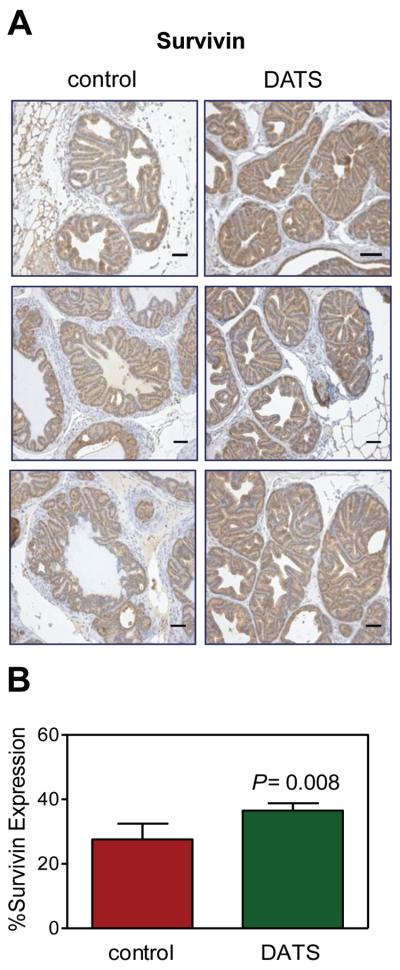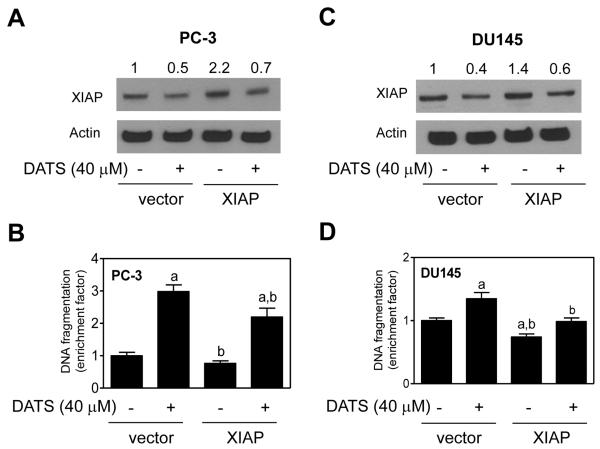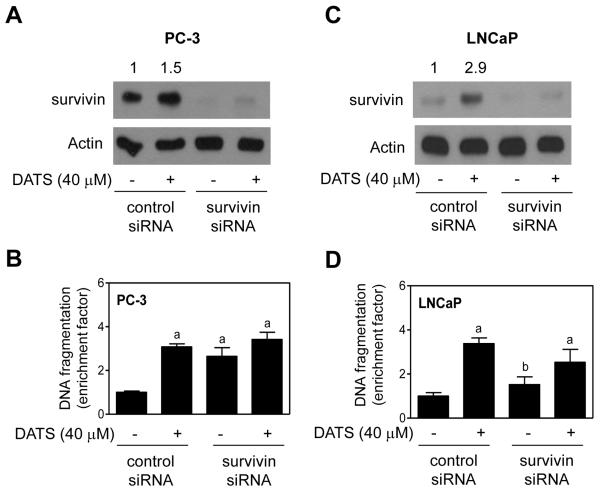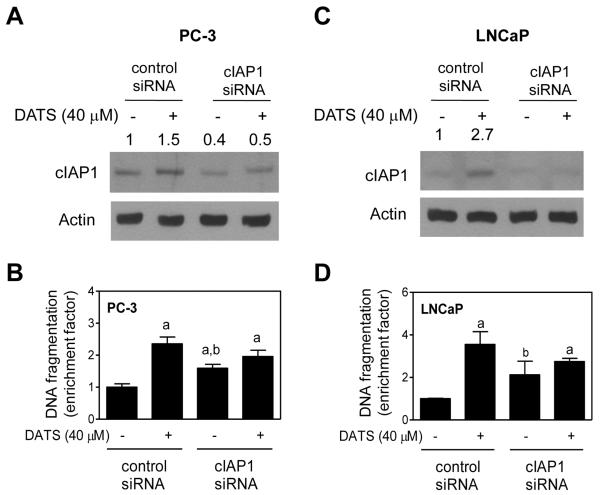Abstract
We have shown previously that garlic constituent diallyl trisulfide (DATS) inhibits growth of cultured and xenografted human prostate cancer cells in association with apoptosis induction, but the mechanism of cell death is not fully understood. The present study systematically investigates role of inhibitor of apoptosis (IAP) family proteins in regulation of DATS-induced apoptosis using cultured PC-3 and LNCaP human prostate cancer cells and dorsolateral prostate from control and DATS-treated Transgenic Adenocarcinoma of Mouse Prostate (TRAMP) mice. Level of X-linked inhibitor of apoptosis (XIAP) protein was decreased upon 8-hour treatment with 20 and 40 μmol/L DATS, but this effect was partially attenuated at the 16-hour time point. DATS-mediated decline in XIAP protein level was partially reversible in the presence of proteasomal inhibitor MG132. In contrast, DATS-treated PC-3 and LNCaP cells exhibited marked induction of survivin and cIAP1 proteins. Induction of survivin protein expression resulting from DATS exposure was associated with an increase in its mRNA level. Dorsolateral prostates from DATS-treated TRAMP mice exhibited statistically significant down-regulation of XIAP and induction of survivin protein compared with those of control mice. Ectopic expression of XIAP conferred partial but significant protection against DATS-induced apoptosis. On the other hand, DATS-induced apoptosis was only marginally affected by RNA interference of survivin or cIAP1. In conclusion, the present study indicates that the DATS-induced apoptosis in prostate cancer cells is mediated in part by suppression of XIAP protein expression, and that XIAP represents a viable biomarker of DATS response for future clinical investigations.
Keywords: Diallyl Trisulfide, IAP, XIAP, Chemoprevention
Introduction
Prostate cancer remains a serious public health concern for men especially those residing in western countries such as United States. In spite of screening efforts and continuous evolution of targeted therapies, thousands of American families are affected by this devastating disease each year (1). Consequently, novel preventive interventions are attractive to reduce health care cost, morbidity, and mortality associated with this malignancy in men. Natural products, including bioactive food components, are attracting increased attention for discovery of small molecules for cell biological applications as molecular probes to ascertain protein function as well as for identification of novel cancer chemopreventive and therapeutic agents (2-5). Organosulfur compounds (OSCs) derived from Allium vegetables (e.g., garlic) appear promising for cancer prevention (6). Chemopreventive OSCs are generated upon processing (cutting or chewing) of Allium vegetables via reactions involving alliinase-mediated enzymatic conversion of S-alk(en)yl-L-cysteine sulfoxide to alkyl alkane thiosulfinates such as allicin followed by instant decomposition of these byproducts (7). Oil-soluble OSCs, including diallyl trisulfide (DATS), have been extensively studied for their cancer chemopreventive effects. The OSCs are effective inhibitors of chemically-induced cancer in experimental rodents (8-10). DATS administration by gavage inhibited growth of PC-3 human prostate cancer cells subcutaneously implanted in male athymic mice without causing any adverse side effects (11). We also demonstrated recently that DATS administration significantly inhibited incidence as well as burden (affected area) of poorly-differentiated prostate cancer and pulmonary metastasis multiplicity in a transgenic mouse model of prostate cancer (Transgenic Adenocarcinoma of Mouse Prostate; hereafter abbreviated as TRAMP) (12). Growth inhibitory effect of DATS against PC-3 cells in vivo was associated with a significant increase in number of apoptotic bodies (11). Dorsolateral prostates from DATS-treated TRAMP mice also exhibited increased abundance of apoptotic bodies in comparison with control, although the difference was not significant (12).
In cultured human prostate cancer cells, DATS treatment has been shown to cause cell cycle arrest, apoptosis induction, and transcriptional repression of androgen receptor (13-19). Furthermore, DATS treatment inhibited angiogenesis in human umbilical vein endothelial cells (20). Studies have provided novel insights into the molecular circuitry of apoptotic cell death resulting from DATS exposure in human prostate cancer cells (13,16,18,21). For example, DATS treatment caused activation of c-Jun N-terminal kinase and inhibition of constitutive as well as interleukin-6 inducible activation of signal transducer and activator of transcription 3 (STAT3) in human prostate cancer cells (13,21). While STAT3 activation was largely dispensable for proapoptotic response to DATS (21), cell death resulting from DATS treatment was significantly attenuated by pharmacological inhibition of c-Jun N-terminal kinase (13).
Apoptosis is a complex process regulated by multiple molecules that function as either promoters (e.g., Bax and Bak, caspases) or inhibitors of the cell death processes (e.g., Bcl-2, Bcl-xL, and inhibitor of apoptosis family proteins) (22-26). The IAP family protein has emerged as critical regulator of caspase-mediated apoptotic cell death by different stimuli (24-26). The IAPs are evolutionarily conserved proteins that serve to inhibit apoptosis by binding to and inhibiting activation of caspases (24-26). Elevated expression of IAP proteins, including X-linked inhibitor of apoptosis (XIAP) and survivin, has been reported in human prostate cancers (27-29). Even though IAP expression did not correlate with Gleason grade or prostate-specific antigen levels (27), high XIAP expression was shown to be strong and independent predictor of human prostate cancer recurrence (29). Previous work from our laboratory has established that the mitochondria-mediated apoptosis induction by DATS treatment is accompanied by induction of Bax and/or Bak in cultured and xenografted human prostate cancer cells (11,13,18). However, the role of IAP family proteins in regulation of DATS-induced apoptosis is unclear. The present study systematically addresses this question using PC-3 (an androgen independent cell line lacking functional p53) and LNCaP (an androgen-responsive cell line expressing wild-type p53) human prostate cancer cells, and dorsolateral prostates from control and DATS-treated TRAMP mice obtained from a previously completed study (12).
Materials and Methods
Reagents
DATS (purity >98%) was purchased from LKT laboratories. Cell culture reagents, including F-12K medium, fetal bovine serum (FBS), and Penicillin/Streptomycin antibiotic mixture were purchased from Invitrogen-Life Technologies; RPMI 1640 medium and minimum essential medium were from Cellgro, and MG132 was from Calbiochem. Antibody against cIAP1 (CS4952) was purchased from Cell Signaling; antibody against XIAP used for Western blotting was purchased from BD Biosciences (610717); antibody against XIAP used for immunohistochemistry was purchased from Abcam (21278); anti-survivin antibody (for immunoblotting and immunohistochemistry) was purchased from Novus Biologicals (NB-500-201); and anti-actin antibody was from Sigma-Aldrich (A5441). Survivin- and cIAP1-targeted small interfering RNA (siRNA) were purchased from Santa Cruz Biotechnology. A nonspecific control siRNA was obtained from Qiagen. Fugene6 transfection reagent and a kit for quantitation of histone-associated apoptotic DNA fragment release into the cytosol was purchased from Roche Diagnostics.
Cell lines
PC-3, LNCaP, and DU145 human prostate cancer cells were obtained from American Type Culture Collection (ATCC). Cell line authentication (PC-3, LNCaP, and DU145) was done by Research Animal Diagnostic Laboratory (University of Missouri, Columbia, MO) to test for inter-species contamination and alleles for short tandem repeats identifiable in the ATCC database. The cells were last tested in July 2010. Each cell line was found to be of human origin. The genetic profiles for PC-3 and LNCaP cells were consistent with the genetic profiles in the ATCC database. The LNCaP cells were maintained in RPMI 1640 medium supplemented with 1 mmol/L sodium pyruvate, 10 mmol/L HEPES, 0.2% glucose, 10% (v/v) FBS, and 1% Penicillin/Streptomycin antibiotic mixtures. PC-3 cells were cultured in F-12K Nutrient Mixture supplemented with 7% (v/v) FBS and 1% Penicillin/Streptomycin antibiotic mixture. DU145 cultures were maintained in minimum essential medium supplemented with 1 mmol/L sodium pyruvate, 0.1 mmol/L nonessential amino acids, 1.5 g/L sodium bicarbonate, 10% (v/v) FBS, and 1% Penicillin/Streptomycin antibiotic mixtures. Each cell line was maintained in an atmosphere of 95% air and 5% CO2 at 37°C. Stock solution of DATS was prepared in dimethyl sulfoxide (DMSO) and an equal volume of DMSO (final concentration 0.1%) was added to the controls.
Immunoblotting
After treatment, cells were collected and lysed as described by us previously (30). Proteins were resolved by SDS-PAGE and transferred onto polyvinylidene fluoride membrane. Immuoblotting was done as described by us previously (14,19,21,30).
Reverse transcription-PCR
Total RNA from DMSO-treated control or DATS-treated cells was isolated using RNeasy kit (Invitrogen-Life Technologies). The cDNA was synthesized with the use of 1 μg of total RNA using SuperScript III reverse transcriptase (Invitrogen) with oligo(dT)20 primer. PCR was done using specific primers (survivin forward- 5′AGGACGGCCCTTCTTGGAGG-3′ and survivin reverse- 5′CTTTTTATGTTCCTCTATGGGGTC-3′; XIAP forward- 5′-AAGAGAAGATGACTTTTAA-3′ and XIAP reverse- 5′-TGCTGAGTCTCCATATTGC-3′) with following amplification conditions: 94°C for 2 minutes, for survivin- 30 cycles at 94°C for 15 seconds, at 60°C for 20 seconds, and at 68°C for 15 seconds, and for XIAP- 28 cycles at 94°C for 45 seconds, at 48°C for 45 seconds, and at 68°C for 45 seconds . Human GAPDH was used as a control as in our previous study (31).
Immunohistochemical analysis for XIAP and survivin protein expression in the dorsolateral prostate of TRAMP mice
We have shown previously that DATS by gavage (2 mg/d/mouse, three times per wk for 13 wk beginning at 8 wk of age; n= 16 for control group and n= 19 for DATS treatment group) significantly inhibits incidence and burden (affected area) of poorly-differentiated prostate cancer in TRAMP mice without suppressing T antigen expression (12). In the present study, we used 4-5 μm sections from paraffin-embedded dorsolateral prostates available from the same study (12) for immunohistochemical analysis of XIAP and survivin. Initially, we selected 5 samples each from the control and the DATS treatment groups matched by prostate weight [control group prostate weight- 234. 6 mg ± 59.4 mg (mean ± SD) versus DATS treatment group- 221.0 mg ± 60.5 mg (mean ± SD)]. Mice of both groups had microscopic evidence of prostate cancer. One section from the control group was damaged during immunohistochemical staining for survivin, and thus was not available for analysis. Because the difference in expression of XIAP and survivin was statistically significant between control and DATS treatment groups even with a small sample size (XIAP- n= 5 for control as well as DATS treatment groups, and survivin- n=4 for control group and n= 5 for DATS treatment group), examination of additional specimens was not necessary. The sections were processed for immunohistochemical analysis of XIAP and survivin as described by us previously for other proteins (11,12). Three to five non-overlapping images from each tumor section were captured and analyzed using Image Pro Plus software as described by us previously (12).
Ectopic expression of XIAP
PC-3 and DU145 cells (5×104 for both cell lines) were seeded in 6-well plates, allowed to attach, and transiently transfected at 60% confluency with empty pcDNA3.1 vector or pcDNA3.1 vector encoding for XIAP (Addgene) using Fugene6. Twenty-four hours after transfection, the cells were treated with DMSO (control) or DATS for specified time period. Cells were collected and processed for immunoblotting and determination of histone-associated DNA fragment release into the cytosol, which is a well-accepted technique for quantitation of apoptotic cell death. Histone-associated DNA fragment release into the cytosol was determined using a kit from Roche Diagnostics and by following the manufacturer's instructions.
RNA interference
PC-3 and LNCaP cells (5×104 for each cell line) were seeded in six-well plates, allowed to attached, and transfected at 50% confluency with 100 nmol/L survivin or cAIP1 targeted siRNA using Oligofectamine. Twenty-four hours after transfection, the cells were treated with DMSO (control) or DATS for specified time period. Subsequently, the cells were collected and processed for immunoblotting and measurement for histone-associated DNA fragment release into the cytosol.
Statistical analysis
Each experiment was performed at least twice with triplicate measurements for quantitative comparisons. Statistical significance of difference in measured variables between control and treated groups was determined by Student's t-test or one-way ANOVA. Difference was considered significant at P < 0.05.
Results
DATS treatment differentially affected levels of IAP proteins in prostate cancer cells
Fig. 1A depicts immunoblotting data for the effect of DATS treatment on levels of IAP family proteins. Protein level of XIAP was suppressed markedly upon 8-hour treatment of PC-3 and LNCaP cells with DATS in a dose-dependent manner. DATS-mediated decline in XIAP protein was partially reversible on extended incubation (16 hours) (Fig. 1A). To the contrary, the DATS-treated PC-3 and LNCaP cells exhibited a marked increase in level of survivin protein especially at the 16-hour time point in both cell lines. Expression of cIAP1 protein was also increased upon treatment of PC-3 and LNCaP cells with DATS (Fig. 1A). These results showed differential effect of DATS treatment on expression of IAP family proteins in prostate cancer cells.
Fig. 1.
A, immunoblotting for XIAP, survivin, and cIAP1 proteins using lysates from PC-3 and LNCaP cells treated for 8- or 16-hours with DMSO (control) or the indicated concentrations of DATS. Blots were stripped and re-probed with anti-actin antibody to correct for differences in protein loading. B, reverse transcription-PCR for XIAP and survivin in PC-3 and LNCaP cells treated for 8- or 16-hours with DMSO or the indicated concentrations of DATS. C, immunoblotting for XIAP protein using lysates from PC-3 and LNCaP cells treated for 16-hours with the indicated concentration of DATS in the absence or presence of the indicated concentration of proteasomal inhibitor MG132. Each experiment was repeated at least twice, and representative data from one such experiment are shown.
To gain insight into the mechanism of DATS-mediated alteration in IAP family proteins, we determined expression of XIAP and survivin mRNA by RT-PCR. This analysis was restricted to XIAP and survivin because the effect of DATS was most pronounced on these proteins. As can be seen in Fig. 1B, the DATS-mediated decrease in XIAP protein level (Fig. 1A) was not due to its transcriptional repression. On the other hand, survivin mRNA level was increased markedly on treatment of PC-3 and LNCaP cells with DATS (Fig. 1B). Interestingly, the DATS-mediated induction of survivin mRNA expression was relatively more pronounced in the PC-3 cells compared with LNCaP.
Next, we questioned whether DATS-mediated down-regulation of XIAP protein expression was due to its proteasomal degradation. We addressed this question using MG132, a well-accepted proteasomal inhibitor. As can be seen in Fig. 1C, DATS-mediated suppression of XIAP protein was markedly reversed in the presence of MG132 in both cell lines. These results indicated that while DATS treatment triggered proteasomal degradation of the XIAP protein, induction of survivin protein resulting from DATS treatment was accompanied by its transcriptional up-regulation.
DATS administration caused down-regulation of XIAP protein and induction of survivin protein in the dorsolateral prostates of TRAMP mice
Previous work from our laboratory has revealed that oral administration of DATS significantly inhibits incidence and burden of poorly-differentiated prostate cancer in the dorsolateral prostate of TRAMP mice without causing any side effects (12). For example, the incidence of poorly-differentiated cancer was reduced by about 34-41% in the dorsolateral prostate of DATS-treated TRAMP mice in comparison with controls (12). We used dorsolateral prostate tissues from this study (control and 2 mg DATS treatment groups) to test in vivo relevance of the cellular results (Fig. 1A). Representative immunohistochemical images for XIAP expression are shown in Fig. 2A. In agreement with cellular data, expression of XIAP protein was modestly but statistically significantly reduced in the dorsolateral prostate of DATS-treated mice compared with that of control mice (Fig. 2B).
Fig. 2.
A, immunohistochemical analysis for XIAP protein expression in the dorsolateral prostates of control and DATS-treated TRAMP mice (magnification, ×200). Scale bar- 1 μm. B, quantitative analysis for XIAP protein expression in the dorsolateral prostates of control and DATS-treated TRAMP mice. Five randomly selected fields from each section were analyzed. Columns, mean (n= 5 for both control and DATS treatment groups); bars, SD. Statistical significance was determined by two-sided Student t-test.
We also performed immunohistochemistry for survivin expression using dorsolateral prostate sections from control and DATS-treated mice, and data for 3 representative mice of each group are shown in Fig. 3A. As can be seen in Fig. 3B, the level of survivin protein was modestly but significantly higher in the dorsolateral prostate of DATS-treated mice compared with those of control mice (Fig. 3B). These results indicated that the DATS-mediated changes in IAP family proteins observed in cultured prostate cancer cells were also evident in vivo.
Fig. 3.
A, immunohistochemical analysis for survivin protein expression in the dorsolateral prostates of control and DATS-treated TRAMP mice (magnification, ×200). Scale bar- 1 μm. B, quantitative analysis for survivin protein expression in the dorsolateral prostates of control and DATS-treated TRAMP mice. Three to five randomly selected fields on each section were analyzed. Columns, mean (n= 4 for control and n= 5 for DATS treatment group); bars, SD. Statistical significance was determined by two-sided Student t-test.
XIAP overexpression conferred partial protection against DATS-induced apoptosis
Because DATS treatment suppressed protein level of XIAP in prostate cancer cells in culture as well as in vivo, we designed functional experiments involving ectopic expression to determine its role in DATS-induced apoptosis. As can be seen in Fig. 4A, the level of XIAP protein was increased by about 2.2-fold in PC-3 cells transfected with the pcDNA3.1 encoding for XIAP in comparison with empty vector transfected control cells (compare lane-1 versus lane-3 in Fig. 4A). Similar to un-transfected PC-3 cells (Fig. 1A), the level of XIAP protein was decreased by 50% upon 24 hour treatment of empty vector transfected control cells with 40 μmol/L DATS (Fig. 4A). Moreover, the XIAP overexpressing PC-3 cells were partially but significantly more resistant to DATS-induced histone-associated DNA fragment release into the cytosol compared with the empty vector transfected control cells (Fig. 4B). Because repeated attempts for overexpression of XIAP protein were unsuccessful in the LNCaP cell line, we utilized another widely-studied human prostate cancer cell line (DU145) for this purpose. Similar to PC-3 cells, a 1.4-fold overexpression of XIAP (Fig. 4C) conferred statistically significant protection against DATS-induced apoptosis in DU145 cells (Fig. 4D). These results indicated that the DATS-induced apoptosis was mediated, at least in part, by suppression of XIAP protein expression.
Fig. 4.
Immunoblotting for XIAP protein using lysates from PC-3 (A) and DU145 (C) cells transiently transfected with empty pcDNA3.1 vector or pcDNA3.1 vector encoding for XIAP and treated with DMSO (control) or 40 μmol/L DATS for 16-24 hours. Numbers above the bands represent change in protein level relative to empty vector-transfected cells treated with DMSO. Histone-associated DNA fragment release into the cytosol (a measure of apoptotic cell death) in PC-3 (B) and DU145 (D) cells transiently transfected with empty pcDNA3.1 vector or pcDNA3.1 vector encoding for XIAP and treated with DMSO (control) or 40 μmol/L DATS for 16-24 hours. Columns, mean (n= 3); bars, SD. Significantly different (P < 0.05) compared with empty vector-transfected cells treated with DMSO (a) and empty vector-transfected cells treated with DATS (b) by one-way ANOVA followed by Bonferroni's multiple comparison test. Comparable results were observed in two independent experiments. Representative data from one such experiment are shown.
Effect of survivin and cIAP1 knockdown on DATS-induced apoptosis
Next, we proceeded to investigate the role of survivin and cIAP1 in regulation of DATS-induced apoptosis with the use of siRNA. Constitutive as well as DATS-inducible expression of survivin protein was reduced by >95% in PC-3 (Fig. 5A) and LNCaP cells (Fig. 5C) upon transient transfection with a survivin-targeting siRNA. Both cell lines became significantly more sensitive to spontaneous histone-associated DNA fragment release into the cytosol by survivin knockdown even in the absence of DATS-treatment (compare Fig. 5B for PC-3 and Fig. 5D for LNCaP cell line). However, enrichment of histone-associated DNA fragment release into the cytosol resulting from DATS exposure over DMSO-treated control did not differ significantly between PC-3 (Fig. 5B) or LNCaP (Fig. 5D) cells transfected with a nonspecific siRNA and survivin-targeting siRNA. Overall conclusions from the experiments involving cIAP1 knockdown in PC-3 (Fig. 6A,B) and LNCaP cells (Fig. 6C,D) were similar to those obtained with RNA interference of survivin. Collectively, these results indicated that while knockdown of survivin and cIAP1 rendered cells more sensitive to spontaneous apoptosis, DATS-induced apoptosis was not affected by their RNA interference.
Fig. 5.
Immunoblotting for survivin using PC-3 (A) and LNCaP cells (C) transiently transfected with a control nonspecific siRNA or a survivin-targeted siRNA and treated with DMSO (control) or 40 μmol/L DATS for 24 hours. Histone-associated DNA fragment release into the cytosol (a measure of apoptotic cell death) in PC-3 (B) and LNCaP cells (D) transiently transfected with a nonspecific siRNA or a survivin-targeted siRNA and treated with DMSO (control) or 40 μmol/L DATS for 24 hours. Columns, mean (n= 3); bars, SD. Significantly different (P < 0.05) compared with nonspecific siRNA-transfected cells treated with DMSO (a) and nonspecific siRNA-transfected cells treated with DATS (b) by one-way ANOVA followed by Bonferroni's multiple comparison test. Results were consistent in two independent experiments, and representative data from one such experiment are shown.
Fig. 6.
Immunoblotting for cIAP1 using PC-3 (A) and LNCaP cells (C) transiently transfected with a control nonspecific siRNA or a cIAP1-targeted siRNA and treated with DMSO (control) or 40 μmol/L DATS for 16 hours. Histone-associated DNA fragment release into the cytosol (a measure of apoptotic cell death) in PC-3 (B) and LNCaP cells (D) transiently transfected with a nonspecific siRNA or a cIAP1-targeted siRNA and treated with DMSO (control) or 40 μmol/L DATS for 16 hours. Columns, mean (n= 3); bars, SD. Significantly different (P < 0.05) compared with nonspecific siRNA-transfected cells treated with DMSO (a) and nonspecific siRNA-transfected cells treated with DATS (b) by one-way ANOVA followed by Bonferroni's multiple comparison test. Results were consistent in two independent experiments, and representative data from one such experiment are shown.
Discussion
DATS is a promising cancer chemopreventive constituent of Allium vegetables with documented preventive efficacy against chemically-induced cancers in rodents (6, 8-10) as well as in transgenic mice prone to spontaneous prostate cancer development (12). Previous cellular and in vivo tumor xenograft experiments have provided convincing evidence to implicate apoptosis in anticancer effect of DATS (11,13,18). The main goal of the present investigation was to gain insights into possible involvement of IAP family proteins in regulation of DATS-induced apoptosis. The IAP family of proteins has emerged as key regulator of apoptosis in response to different stimuli, including death receptor activation, growth factor withdrawal, radiation, and genotoxic insults (32-34). The IAPs are structurally characterized by the presence of baculovirus IAP repeat (BIR) domains (33). Of the eight IAP members XIAP (also referred to as BIRC4 or BIR-containing protein 4) is the best characterized and most potent inhibitor of caspase-3 and -7 (32). Anti-caspase activity of XIAP is attributed to its BIR domains; BIR3 domain inhibits caspase-9 whereas the BIR2 linker region is implicated in inhibition of caspase-3 and -7 (32). In addition, XIAP overexpression correlates with poor prognosis in some but not all cancers (32,35,36). The present study reveals that DATS treatment decreases protein level of XIAP in cultured prostate cancer cells by promoting its proteasomal degradation. These results are consistent with literature showing that XIAP is capable of auto-ubiquitination and can be stabilized by inhibition of the proteasome (37,38). DATS-mediated suppression of XIAP protein is neither a cell line-specific response nor influenced by the androgen-responsiveness or p53 status because similar results are evident in PC-3 and LNCaP cells. The DATS-mediated suppression is not restricted to cultured prostate cancer cells as oral DATS administration statistically significantly diminishes XIAP protein expression in the dorsolateral prostates of TRAMP mice. Moreover, overexpression of XIAP confers partial but significant protection against DATS-induced apoptosis. Collectively, these results indicate that suppression of XIAP contributes, at least in part, to DATS-induced apoptosis and that XIAP may be a viable biomarker of DATS response.
Survivin (BIRC5) is another IAP family member that contains a single BIR domain and an extended C-terminal helical coiled-coil domain, but unlike other IAPs, survivin lacks the RING-finger domain (24,26,33). Survivin has been shown to play an important role in both cell cycle regulation and apoptosis control (39). Survivin expression is absent or very low in most terminally differentiated normal tissues, but this protein is overexpressed in different types of cancers (27,39,40). Survivin overexpression not only correlates with clinical pathologic variables of the aggressive disease but also confers treatment resistance in cancer cells (39,41). It is interesting to note that DATS treatment causes transcriptional up-regulation of survivin in prostate cancer cells, which is not a cell line-specific phenomenon. However, survivin up-regulation is unable to confer resistance against DATS-induced apoptosis because survivin knockdown has minimal effect on cell death resulting from DATS exposure. On the other hand, survivin knockdown alone renders prostate cancer cells more sensitive to spontaneous apoptosis through mechanisms not yet clear.
Expression of cIAP1 (BIRC2) is cell cycle-dependent peaking in G2/M phase of the cell cycle and contributes to survival during mitotic arrest (42). This protein has almost exclusive nuclear localization in proliferating cells, but is excluded from the nucleus during differentiation (43). An integrative oncogenomics approach classifies cIAP1 as having oncogenic properties (44). cIAP1 is a target gene within an amplicon at 11q22 found in 4-10% of esophageal, cervical, and hepatocellular cancers (44,45). It was also documented recently that cIAP1 can interact with Max-dimerization protein-1, which is a negative regulator of Myc transcription factor, suggesting that cIAP may cooperate with c-myc to promote cell proliferation (46). Overexpression of cIAP1 in DU145 cells has been shown to trigger polypoidy (47). Similar to survivin, the DATS-treated PC-3 and LNCaP cells exhibit induction of the cIAP1 protein expression. Even though the mechanism underlying DATS-mediated induction of cIAP protein is not known, knockdown of cIAP1 protein has minimal effect on cell death resulting from DATS exposure in both PC-3 and LNCaP cells. Similar to survivin, knockdown of cIAP1 protein level increase spontaneous apoptosis in both PC-3 and LNCaP cells. These observations underscore efforts devoted to development of small molecular inhibitors of IAPs for cancer therapeutic purposes.
Four critical conclusions are discernible from the results described herein. First, the DATS-mediated alteration in IAP family proteins observed in cultured cells is generally translated in vivo. Second, DATS-induced apoptosis in prostate cancer cell is partially mediated by suppression of XIAP protein expression. Third, XIAP may serve as a useful biomarker to assess DATS response in future clinical investigations. Finally, DATS treatment causes induction of survivin and cIAP1 proteins but knockdown of their protein levels has minimal impact on DATS-mediated apoptosis.
Acknowledgments
Grant Support: This study was supported by the USPHS grant RO1 CA113363-06, awarded by the National Cancer Institute.
Footnotes
Conflict of Interest: None.
References
- 1.Jemal A, Siegel R, Xu J, Ward E. Cancer Statistics, 2010. CA Cancer J Clin. 2010;60:277–300. doi: 10.3322/caac.20073. [DOI] [PubMed] [Google Scholar]
- 2.Shen J, Xu X, Cheng F, et al. Virtual screening on natural products for discovering active compounds and target information. Curr Med Chem. 2003;10:2327–42. doi: 10.2174/0929867033456729. [DOI] [PubMed] [Google Scholar]
- 3.Zhang Y, Yeh JR, Mara A, et al. A chemical and genetic approach to the mode of action of fumagillin. Chem Biol. 2006;13:1001–9. doi: 10.1016/j.chembiol.2006.07.010. [DOI] [PMC free article] [PubMed] [Google Scholar]
- 4.Surh YJ. Cancer chemoprevention with dietary phytochemicals. Nat Rev Cancer. 2003;3:768–80. doi: 10.1038/nrc1189. [DOI] [PubMed] [Google Scholar]
- 5.Newman DJ, Cragg GM, Snader KM. Natural products as sources of new drugs over the period 1981-2002. J Nat Prod. 2003;66:1022–37. doi: 10.1021/np030096l. [DOI] [PubMed] [Google Scholar]
- 6.Herman-Antosiewicz A, Powolny AA, Singh SV. Molecular targets of cancer chemoprevention by garlic-derived organosulfides. Acta Pharmacol Sin. 2007;28:1355–64. doi: 10.1111/j.1745-7254.2007.00682.x. [DOI] [PubMed] [Google Scholar]
- 7.Block E. The organosulfur chemistry of the genus Allium- implications for the organic chemistry of sulfur. Angew Chem Int Ed Engl. 1992;31:1135–78. [Google Scholar]
- 8.Sparnins VL, Barany G, Wattenberg LW. Effects of organosulfur compounds from garlic and onions on benzo[a]pyrene-induced neoplasia and glutathione S-transferase activity in the mouse. Carcinogenesis. 1988;9:131–4. doi: 10.1093/carcin/9.1.131. [DOI] [PubMed] [Google Scholar]
- 9.Wargovich MJ, Woods C, Eng VW, Stephens LC, Gray K. Chemoprevention of N-nitrosomethylbenzylamine-induced esophageal cancer in rats by the naturally occurring thioether, diallyl sulfide. Cancer Res. 1988;48:6872–5. [PubMed] [Google Scholar]
- 10.Reddy BS, Rao CV, Rivenson A, Kelloff G. Chemoprevention of colon carcinogenesis by organosulfur compounds. Cancer Res. 1993;53:3493–8. [PubMed] [Google Scholar]
- 11.Xiao D, Lew KL, Kim YA, et al. Diallyl trisulfide suppresses growth of PC-3 human prostate cancer xenograft in vivo in association with Bax and Bak induction. Clin Cancer Res. 2006;12:6836–43. doi: 10.1158/1078-0432.CCR-06-1273. [DOI] [PubMed] [Google Scholar]
- 12.Singh SV, Powolny AA, Stan SD, et al. Garlic constituent diallyl trisulfide prevents development of poorly differentiated prostate cancer and pulmonary metastasis multiplicity in TRAMP mice. Cancer Res. 2008;68:9503–11. doi: 10.1158/0008-5472.CAN-08-1677. [DOI] [PMC free article] [PubMed] [Google Scholar]
- 13.Xiao D, Choi S, Johnson DE, et al. Diallyl trisulfide-induced apoptosis in human prostate cancer cells involves c-Jun N-terminal kinase and extracellular-signal regulated kinase-mediated phosphorylation of Bcl-2. Oncogene. 2004;23:5594–606. doi: 10.1038/sj.onc.1207747. [DOI] [PubMed] [Google Scholar]
- 14.Herman-Antosiewicz A, Singh SV. Checkpoint kinase 1 regulates diallyl trisulfide-induced mitotic arrest in human prostate cancer cells. J Biol Chem. 2005;280:28519–28. doi: 10.1074/jbc.M501443200. [DOI] [PubMed] [Google Scholar]
- 15.Xiao D, Herman-Antosiewicz A, Antosiewicz J, et al. Diallyl trisulfide-induced G(2)-M phase cell cycle arrest in human prostate cancer cells is caused by reactive oxygen species-dependent destruction and hyperphosphorylation of Cdc 25 C. Oncogene. 2005;24:6256–68. doi: 10.1038/sj.onc.1208759. [DOI] [PubMed] [Google Scholar]
- 16.Xiao D, Singh SV. Diallyl trisulfide, a constituent of processed garlic, inactivates Akt to trigger mitochondrial translocation of BAD and caspase-mediated apoptosis in human prostate cancer cells. Carcinogenesis. 2006;27:533–40. doi: 10.1093/carcin/bgi228. [DOI] [PubMed] [Google Scholar]
- 17.Herman-Antosiewicz A, Stan SD, Hahm ER, Xiao D, Singh SV. Activation of a novel ataxia-telangiectasia mutated and Rad3 related/checkpoint kinase 1-dependent prometaphase checkpoint in cancer cells by diallyl trisulfide, a promising cancer chemopreventive constituent of processed garlic. Mol Cancer Ther. 2007;6:1249–61. doi: 10.1158/1535-7163.MCT-06-0477. [DOI] [PubMed] [Google Scholar]
- 18.Kim YA, Xiao D, Xiao H, et al. Mitochondria-mediated apoptosis by diallyl trisulfide in human prostate cancer cells is associated with generation of reactive oxygen species and regulated by Bax/Bak. Mol Cancer Ther. 2007;6:1599–609. doi: 10.1158/1535-7163.MCT-06-0754. [DOI] [PMC free article] [PubMed] [Google Scholar]
- 19.Stan SD, Singh SV. Transcriptional repression and inhibition of nuclear translocation of androgen receptor by diallyl trisulfide in human prostate cancer cells. Clin Cancer Res. 2009;15:4895–903. doi: 10.1158/1078-0432.CCR-09-0512. [DOI] [PMC free article] [PubMed] [Google Scholar]
- 20.Xiao D, Li M, Herman-Antosiewicz A, et al. Diallyl trisulfide inhibits angiogenic features of human umbilical vein endothelial cells by causing Akt inactivation and down-regulation of VEGF and VEGF-R2. Nutr Cancer. 2006;55:94–107. doi: 10.1207/s15327914nc5501_12. [DOI] [PubMed] [Google Scholar]
- 21.Chandra-Kuntal K, Singh SV. Diallyl trisulfide inhibits activation of signal transducer and activator of transcription 3 in prostate cancer cells in culture and in vivo. Cancer Prev Res. 2010;3:1473–83. doi: 10.1158/1940-6207.CAPR-10-0123. [DOI] [PMC free article] [PubMed] [Google Scholar]
- 22.Reed JC. Bcl-2 family proteins: regulators of apoptosis and chemoresistance in hematologic malignancies. Semin. Hematol. 1997;34:9–19. [PubMed] [Google Scholar]
- 23.Thornberry NA, Lazebnik Y. Caspases: enemies within. Science. 1998;281:1312–6. doi: 10.1126/science.281.5381.1312. [DOI] [PubMed] [Google Scholar]
- 24.LaCasse EC, Baird S, Korneluk RG, MacKenzie AE. The inhibitors of apoptosis (IAPs) and their emerging role in cancer. Oncogene. 1998;17:3247–59. doi: 10.1038/sj.onc.1202569. [DOI] [PubMed] [Google Scholar]
- 25.Deveraux QL, Reed JC. IAP family proteins-suppressors of apoptosis. Genes Dev. 1999;13:239–52. doi: 10.1101/gad.13.3.239. [DOI] [PubMed] [Google Scholar]
- 26.Srinivasula SM, Ashwell JD. IAPs: what's in a Name? Mol Cell. 2008;30:123–35. doi: 10.1016/j.molcel.2008.03.008. [DOI] [PMC free article] [PubMed] [Google Scholar]
- 27.Krajewska M, Krajewski S, Banares S, et al. Elevated expression of inhibitor of apoptosis proteins in prostate cancer. Clin Cancer Res. 2003;9:4914–25. [PubMed] [Google Scholar]
- 28.Berezovskaya O, Schimmer AD, Glinskii AB, et al. Increased expression of apoptosis inhibitor protein XIAP contributes to anoikis resistance of circulating human prostate cancer metastasis precursor cells. Cancer Res. 2005;65:2378–86. doi: 10.1158/0008-5472.CAN-04-2649. [DOI] [PubMed] [Google Scholar]
- 29.Seligson DB, Hongo F, Huerta-Yepez S, et al. Expression of X-linked inhibitor of apoptosis protein is a strong predictor of human prostate cancer recurrence. Clin Cancer Res. 2007;13:6056–63. doi: 10.1158/1078-0432.CCR-07-0960. [DOI] [PubMed] [Google Scholar]
- 30.Xiao D, Srivastava SK, Lew KL, et al. Allyl isothiocyanate, a constituent of cruciferous vegetables, inhibits proliferation of human prostate cancer cells by causing G2/M arrest and inducing apoptosis. Carcinogenesis. 2003;24:891–7. doi: 10.1093/carcin/bgg023. [DOI] [PubMed] [Google Scholar]
- 31.Kim SH, Singh SV. D,L-Sulforaphane causes transcriptional repression of androgen receptor in human prostate cancer cells. Mol Cancer Ther. 2009;8:1946–54. doi: 10.1158/1535-7163.MCT-09-0104. [DOI] [PMC free article] [PubMed] [Google Scholar]
- 32.Dean EJ, Ranson M, Blackhall F, Dive C. X-linked inhibitor of apoptosis protein as a therapeutic target. Expert Opin Ther Targets. 2007;11:1459–71. doi: 10.1517/14728222.11.11.1459. [DOI] [PubMed] [Google Scholar]
- 33.Dubrez-Daloz L, Dupoux A, Cartier J. IAPs: more than just inhibitors of apoptosis proteins. Cell Cycle. 2008;7:1036–46. doi: 10.4161/cc.7.8.5783. [DOI] [PubMed] [Google Scholar]
- 34.Rothe M, Pan MG, Henzel WJ, Ayres TM, Goeddel DV. The TNFR2-TRAF signaling complex contains two novel proteins related to baculoviral inhibitor of apoptosis proteins. Cell. 1995;83:1243–52. doi: 10.1016/0092-8674(95)90149-3. [DOI] [PubMed] [Google Scholar]
- 35.Tamm I, Komblau SM, Segall H, et al. Expression and prognostic significance of IAP-family genes in human cancers and myeloid leukemias. Clin Cancer Res. 2000;6:1796–1803. [PubMed] [Google Scholar]
- 36.Li M, Song T, Yin ZF, Na YQ. XIAP as a prognostic marker of early recurrence of nonmuscular invasive bladder cancer. Chin Med J (Engl.) 2007;120:469–73. [PubMed] [Google Scholar]
- 37.Yang Y, Fang S, Jensen JP, Weissman AM, Ashwell JD. Ubiquitin protein ligase activity of IAPs and their degradation in proteasomes in response to apoptotic stimuli. Science. 2000;288:874–7. doi: 10.1126/science.288.5467.874. [DOI] [PubMed] [Google Scholar]
- 38.Galban S, Duckett CS. XIAP as a ubiquitin ligase in cellular signaling. Cell Death Differ. 2010;17:54–60. doi: 10.1038/cdd.2009.81. [DOI] [PMC free article] [PubMed] [Google Scholar]
- 39.Altieri DC. The case for survivin as a regulator of microtubule dynamics and cell-death decisions. Curr Opin Cell Biol. 2006;18:609–15. doi: 10.1016/j.ceb.2006.08.015. [DOI] [PubMed] [Google Scholar]
- 40.Ambrosini G, Adida C, Altieri DC. A novel anti-apoptosis gene, survivin, expressed in cancer and lymphoma. Nat Med. 1997;3:917–21. doi: 10.1038/nm0897-917. [DOI] [PubMed] [Google Scholar]
- 41.Pennati M, Folini M, Zaffaroni N. Targeting survivin in cancer therapy: fulfilled promises and open questions. Carcinogenesis. 2007;28:1133–9. doi: 10.1093/carcin/bgm047. [DOI] [PubMed] [Google Scholar]
- 42.Jin HS, Lee TH. Cell cycle-dependent expression of cIAP2 at G2/M phase contributes to survival during mitotic cell cycle arrest. Biochem J. 2006;399:335–42. doi: 10.1042/BJ20060612. [DOI] [PMC free article] [PubMed] [Google Scholar]
- 43.Plenchette S, Cathelin S, Rebe C, et al. Translocation of the inhibitor of apoptosis protein c-IAP1 from the nucleus to the Golgi in hematopoietic cells undergoing differentiation: a nuclear export signal-mediated event. Blood. 2004;104:2035–43. doi: 10.1182/blood-2004-01-0065. [DOI] [PubMed] [Google Scholar]
- 44.Zender L, Spector MS, Xue W, et al. Identification and validation of oncogenes in liver cancer using an integrative oncogenomic approach. Cell. 2006;125:1253–67. doi: 10.1016/j.cell.2006.05.030. [DOI] [PMC free article] [PubMed] [Google Scholar]
- 45.Imoto I, Yang ZQ, Pimkhaokham A, et al. Identification of cIAP1 as a candidate target gene within an amplicon at 11q22 in esophageal squamous cell carcinomas. Cancer Res. 2001;61:6629–34. [PubMed] [Google Scholar]
- 46.Xu L, Zhu J, Hu X, et al. c-IAP1 cooperates with Myc by acting as a ubiquitin ligase for Mad1. Mol Cell. 2007;28:914–22. doi: 10.1016/j.molcel.2007.10.027. [DOI] [PubMed] [Google Scholar]
- 47.Samuel T, Okada K, Hyer M, Welsh K, Zapata JM, Reed JC. cIAP1 Localizes to the nuclear compartment and modulates the cell cycle. Cancer Res. 2005;65:210–8. [PubMed] [Google Scholar]



